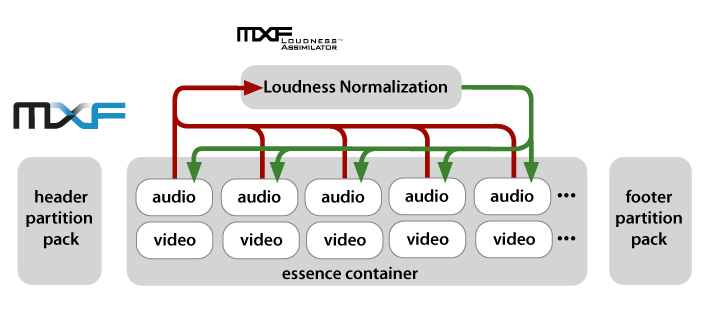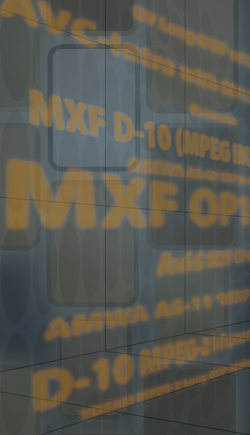MXF Loudness Assimilator
Do you have to provide MXF files which have to be compliant with the new loudness normalisation standards? Are you looking for a tool to easily integrate in your existing workflow, doing the necessary processing highly reliably and in high-speed?

For this purpose, Cube-Tec developed the MXF Loudness Assimilator. It is available as an easy to integrate standalone webservice (SOAP) with an optional watchfolder interface.
The MXF Loudness Assimilator does not touch the video essence or anything else in the MXF container, only for the audio essence. So it's not going to change or modify your file's MXF structure (something to be very careful about!) – only the contents of the audio essence gets loudness normalized in high-speed.
Alternatively, the necessary correction gain can also be added as metadata without altering the audio essence. Thus, loudness adaption may be implemented in the play-out-system.
Loudness Correction
Loudness correction according to current EBU, ITU, ATSC, ARIB recommendations


Cube-Tec's MXF Loudness Assimilator performs automatic loudness correction in accordance with EBU R 128, ITU-R BS.1770-1/1770-2, ATSC A/85 and ARIB TR-B32. It enables you to take complete MXF file collections and bring their sound to a uniform loudness level, so that you won't be faced with level jumps between different files anymore – as it often occurs with MXF files produced by different facilities, or simply because the original audio production between files was done at different times or in different eras.
Also new challenges for broadcasters, for example as caused by the United States "CALM Act" legislation (which specifies that program and commercials audio volume have to be regulated so that they match each other), can easily be solved by MXF Loudness Assimilator.
Workflow Options and Processing Features
The MXF Loudness Assimilator is available as an easy to integrate standalone webservice (SOAP) with an optional watchfolder interface. Three processing modes are possible, depending on the needs of your business workflow:
Optimized workflow options
- high-speed in-place overwriting of MXF audio essences with loudness corrected audio data (this happens on the original input file and thus eliminates the need for file copying).
- copy and normalize the MXF audio essence in in one step. A simple move from source to destination with normalize correction included.
- calculating file-based loudness adaption values and providing metadata to control the leveller in a play-out system (this will not modify the MXF files at all – only additional metadata information is generated and proper playback gains for each file are passed on to the play-out system).
Features and benefits
Processing the audio essence in MXF files for loudness correction offers the following features and benefits:
- measurement of Program Loudness (EBU and ITU modes), max. Short-Term Loudness (STL), max. Momentary Loudness (ML), Loudness Range and True-Peak Level
- loudness correction according to selectable mode (with user definable Desired Loudness and Tolerance)
- Clip Protection function with definable max. True-Peak Level
- processing of mono, stereo and multichannel audio signals
- metadata-based storage of all results
Audio essence processing features
Assimilation to the desired loudness value can eitherbe done according to EBU R 128 / ITU-R BS.1770-2 or ITU-R BS.1770-1. The first mode has the advantage of disregarding low-level audio passages, so they are not taken into account for loudness determination. As a result the measurement is very close to the subjectively perceived loudness level. Optionally, a maximum permitted True-Peak Level can be defined for the loudness correction procedure, to avoid signal peaks exceeding a certain value. A measure for dynamics of audio signals is also calculated in accordance with the Loudness Range determination procedure as defined in EBU R 128. Measurements of input and ouput signals are provided, so that any changes by the MXF Loudness Assimilator can be tracked. The complete results are accessible in file-based metadata.
Format Support
Cube-Tec's MXF Loudness Assimilator supports a variety of MXF flavours, including the following MXF Wrapper formats:

- MXF OP1a
- MXF D-10 (MPEG IMX)
- Avid MXF OP-Atom
- AMWA AS-02 'MXF Versioning'
- AMWA AS-11 'MXF for Contribution'
The following essence types are supported:
- D-10 MPEG-2 I-Frame only with 30/40/50 Mbit/s
- DV Long GOP with 25/50/100 Mbit/s
- XDCAM MPEG-2 Long GOP 422P@HL, MP@HL , MP@H14
- AVC-Intra with 50/100 Mbit/s
- Avid MJPEG
- Uncompressed UYVY / v210
- VC-3 (Avid DNxHD)
- WAVE PCM, BWF, AES3
- Dolby E (in development)
Related Products
MXF Legalizer – solving interoperability issues along with loudness normalization

Does it happen in your organization that you get MXF files delivered that do not work as you expect? Do you have to maintain a large archive with a diversity of MXF flavours and need to make sure that all files in your archive will still work fine in a few years and after updating your equipment? Are you uncertain about how to leverage MXF throughout your facility workflows?
MXF Legalizer is designed to solve your compliance issues and will foster MXF interoperability throughout your workplace.
DOBBIN Loudness Assimilator – uniform loudness in your audio file archive

Automate the loudness adjustment in your pure audiofile-based workflows in accordance with EBU R 128, ITU-R BS.1770-1/1770-2 and ATSC A/85. DOBBIN‘s Loudness Assimilator FPU (File Processing Unit) enables you to take complete audio collections of various formats (WAVE, BWF, MBWF, RF64 etc.) and bring them to a uniform loudness.

